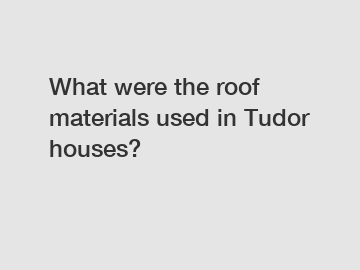What were the roof materials used in Tudor houses?
When it comes to Tudor houses, one of the most striking features is the unique roofing materials used to construct these beautiful homes. The Tudor period, which spanned from 1485 to 1603, saw a variety of roofing materials being utilized, each with its own distinct characteristics and charm. In this blog post, we will explore the different types of roof materials that were commonly used in Tudor houses, and the reasons behind their popularity during this time.
One of the most prevalent roof materials used in Tudor houses was thatch. Thatch is a traditional roofing material made from dry vegetation such as straw, water reed, or sedge. It was a popular choice for Tudor homes due to its abundance and affordability. Thatch provided excellent insulation and was able to withstand the harsh weather conditions of England. Additionally, the natural look of thatch added to the rustic charm of Tudor houses, giving them a cozy and inviting feel.
Another commonly used roofing material in Tudor houses was clay tiles. Clay tiles were durable and long-lasting, making them a practical choice for homeowners looking for a roof that would stand the test of time. The distinctive red color of clay tiles added a pop of color to the Tudor landscape, creating a visually appealing contrast with the dark timber frames of the houses. Clay tiles were also relatively easy to install and maintain, making them a popular choice among Tudor builders.

In addition to thatch and clay tiles, slate was another popular roofing material used in Tudor houses. Slate is a natural stone that is known for its durability and resistance to the elements. It was often used on roofs of higher-end Tudor homes, adding a touch of elegance and sophistication to the overall design. The gray color of slate complemented the earthy tones of the timber frames, creating a harmonious and cohesive look.
Wood shingles were also a common roofing material used in Tudor houses. Wood shingles were typically made from cedar or oak, and were prized for their natural beauty and charm. Wood shingles were popular among homeowners who wanted to achieve a more rustic and traditional look for their homes. While wood shingles required more maintenance than other roofing materials, the aesthetic appeal they provided was well worth the effort.
In addition to these traditional roofing materials, Tudor houses often featured decorative elements such as gables, dormer windows, and intricate patterns of timber framing. These architectural details added to the overall charm and character of Tudor homes, making them stand out in the English countryside.
In conclusion, the roofing materials used in Tudor houses were a reflection of the time period and the values of the people who lived in them. Each material had its own unique qualities and contributed to the overall look and feel of Tudor architecture. From the rustic charm of thatch to the elegance of slate, Tudor roofs were as diverse and varied as the homes themselves. Today, Tudor houses stand as a testament to the craftsmanship and creativity of the builders who constructed them, and continue to inspire homeowners and architects alike with their timeless beauty.
Contact us to discuss your requirements of what is the best stone-coated steel roofing, stone-coated steel roofing, mosaic roofing. Our experienced sales team can help you identify the options that best suit your needs.
- Previous: How much does rebar cost per piece?
- Next: None


